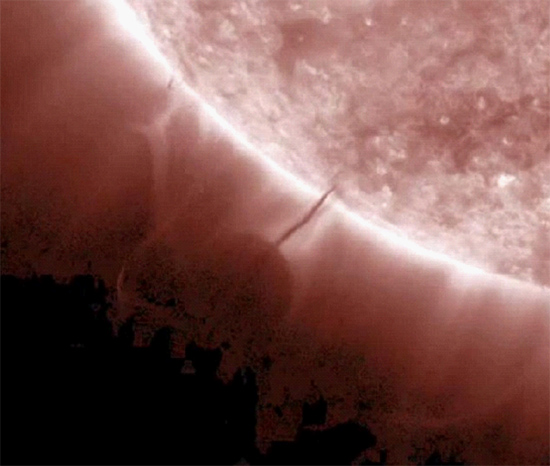Sep 20, 2012
Charged vortices erupting from the Sun can form relatively dark cavities.
Recently, much has been made about a so-called “black sphere connected to the Sun.” Outlandish claims that a solid object was in close solar orbit, “feeding” off the photospheric plasma, have appeared in various places on the internet.
The Sun is a ball of plasma approximately 1.4 million kilometers in diameter. As such, it tends to behave electromagnetically and not according to thermal or mechanical physics. The Sun is the locus of positive charge with respect to the Interstellar Medium (ISM), a stream of high-energy particles, or plasma, flowing through our galaxy. A magnetically confined bubble known as the heliosphere isolates the Sun from the ISM.
Laboratory experiments with a positively charged sphere show that a plasma torus forms above the Sun’s equator. Electric discharges known as sunspots sometimes bridge the torus with the Sun’s middle and lower latitudes, punching holes through the photosphere.
Rotating filaments of plasma can be seen in the penumbrae of sunspots, indicating that they are whirling charge vortices. Since electric discharges in plasma create rope-like, hollow tendrils, they form into funnels of plasma with dark centers. Since the penumbral filaments have a helical structure that maintain a constant diameter, they might be thought of as glowing plasma tornadoes. Rapidly spinning tubes of charged particles produce a powerful magnetic field, causing the particles to concentrate at the periphery of the vortex. Looking through these semi-transparent tubes of glowing plasma side-on, the edges appear bright, while the center is dark.
Coronal arches and multiple looping electromagnetic structures connect sunspots to each other, rising high enough to penetrate the chromosphere. The chromosphere is also a double layer region of the Sun, or plasma sheath, formed by the current flowing between the Sun and its environment. When the electric charges flowing through the Sun’s plasma sheath reach a critical threshold, the double layer may explode, causing solar flares and enormous prominence eruptions.
Electric Universe theory assumes that celestial bodies interact through conductive plasma and are connected by circuits, so the Sun is assumed to be electrically connected with the galaxy. The Sun’s input power is not stable, however. The charges flowing into and out of the Sun can sometimes increase to the point where it releases solar flares or coronal mass ejections (CME).
Solar flares are equivalent to tremendous lightning bursts on the Sun, pushing masses of plasma outward for millions of kilometers. Those plasma bursts are also helical in nature, sometimes containing darker voids within them. Since the structures are electromagnetically confined, they can be quasi-stable in the Sun’s atmosphere for minutes or even hours. The bubble within the CME shown at the top of the page is a normal plasma structure that lasted for over two days.
Whenever phenomena on the Sun are considered, its tremendous size must also factor in. Plasma phenomena are scalable up to many orders of magnitude. What can be modeled in laboratory experiments might take milliseconds, but when those activities are scaled to over a million kilometers, they might remain visible for a relatively long time.
Stephen Smith













